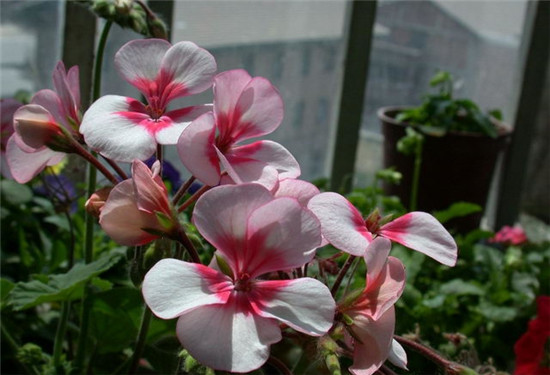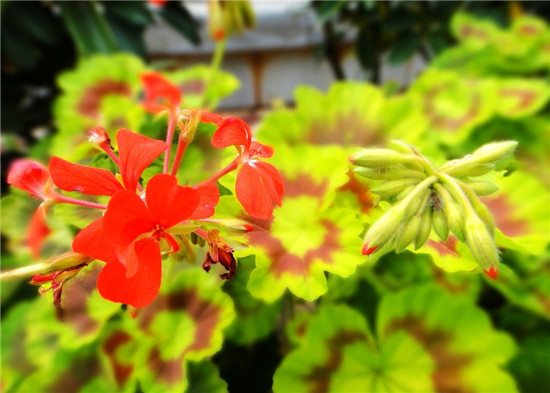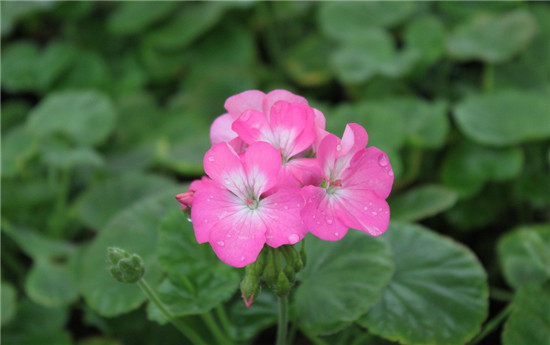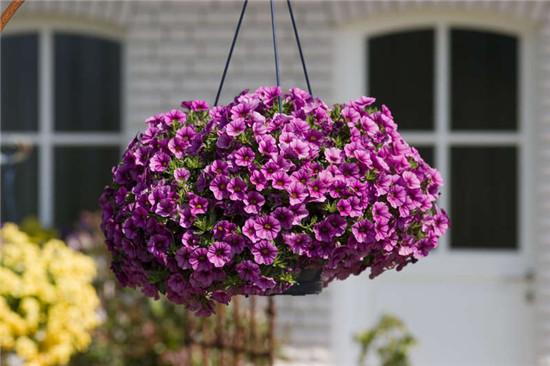[geranium] Culture and maintenance of geranium
Geranium, which was first grown in South Africa, is an erect herbaceous flower and has been cultivated in many varieties. Next, let's take a look at the cultivation and conservation of geraniums.

Geranium, alias Hydrangea, native to South Africa, is a perennial herbaceous flower. The leaf has a long handle, the leaf margin is serrated, and the leaf surface has deep annular markings. Corolla usually 5-merous, inflorescences umbellate, growing at tip of straight pedicel. Because the flowers are as dense as balls, it is also known as hydrangea. The colors of red, white, pink and purple vary a lot. The florescence begins in early winter and lasts until the beginning of summer. Potted plants should be used for indoor and outdoor decoration; they can also be used as flowers in spring flower beds. Geraniums are usually cultivated as 2012 flowers. The base is slightly lignified and the stem is succulent. Leaves heart dirty, green, often with horseshoe-shaped rings. Umbels terminal, buds drooping, Corolla red, white, light red, orange and other colors, as well as single, semidouble, double and tetraploid varieties.
The geranium can generally grow to 30-60cm high, the stem is fleshy, the base is woody, there are unbranched and multi-branched, the nodes of the plant can be seen, and the whole is covered with pilose. Leaves orbicular to reniform alternate have conspicuous markings and margin serrated. The umbrella-shaped inflorescence grows at the top of the stem, and the Corolla is generally 5-petaled, with more colors, mainly red, and others are pink, purple, white, mixed color, etc., because the flowers are globular, so they are also called hydrangea.

Ornamental value: the plant is straight, palm-shaped, with individual horseshoe-shaped patterns on the leaf, and multiple Corollas form globular flowers with a variety of colors, which is a good decoration for indoor and outdoor plants, whether in the room or in the flower bed of the outer courtyard. Can bring it to life.
Medicinal value: in medicine, it can improve immunity, resist bacteria, stop bleeding and pain, accelerate cell metabolism and circulation, purify and repair skin, and play a positive role in the treatment of burns, herpes and other skin problems. Through facial application or aromatherapy, it can stimulate the lymphatic system and speed up circulation, which is conducive to the treatment of colitis and gastritis. For women's menstruation and chest development can also play a certain regulatory effect, reduce mammary gland hyperplasia problems, pay attention to pregnant women are not available.
Perennial herbs, stems erect, base Lignified, distal fleshy, much branched or unbranched, with distinct nodes, densely pubescent, strongly fishy leaves alternate; stipules broadly triangular or ovate, 8-15 mm long, pilose and glandular hairy; petiole 3-10 m long, pilose and glandular hairy The leaf blade is round or reniform, the stem is heart-shaped, 3-7 cm in diameter, the margin is undulate and lobed, with rounded teeth, both sides are transparent pubescent, and there are dark red horseshoe-shaped rings within the leaf margin.

Culture methods of geraniums
Soil: choose the soil with humus and good drainage, can be properly mixed with a small amount of sandy soil to increase its looseness, can also add a little rice chaff ash, bone powder, etc., water can not be added. The potted soil should be changed every year to promote its flowering and growth.
Lighting: adequate light should be provided during the growing period, but direct sunlight should be avoided, especially in summer, so as not to be anxious, sufficient light should be received in winter, placed in a sunny place, and artificial light should be taken if necessary, so as not to cause the plant to wither ahead of time.
Temperature: the plant is suitable to grow in a place where it is warm in winter and cool in summer, 10-25 ℃ is the best, keep 10-15 ℃ in winter, do not lower than 8 ℃ at night, and promote its normal flowering. When the high temperature is above 35 ℃, the plant will be semi-dormant, so the temperature should be fully cooled in summer.
Moisture: it likes the dry environment, especially the water that can not be watered too much in winter, it should be dry and wet, and it can be watered once every 3 days on average. Moist soil will slow down plant growth and flower opening, over time, plant root instability will move up, the emergence of yellow leaves and fallen leaves.

Fertilization: a small amount of fertilizer can be added appropriately, otherwise it will affect its flowering. Generally in early spring or early autumn, it can be applied with some phosphorus and potassium fertilizer to promote growth. If you want the flowers to bloom vigorously, you can apply dilute fertilizer and water at intervals of 1 to 2 weeks and 800 times potassium dihydrogen phosphate solution for 7 to 10 days.
Disease: when it is wet and poorly ventilated, the plant will suffer from flower wilt and leaf spot. Treatment: improve the ventilation environment, immediately remove diseased branches and leaves and withered flowers, so as not to affect the good parts, and then spray the same amount of Bordeaux liquid. In addition, plants are vulnerable to whitefly, nematode and red spider, which can be removed by spraying 1000 times of furan and 10 times of water.
Pruning: pruning some branches where there are many branches to make the flowers bloom as much as possible. Picking hearts frequently can speed up branch growth and cultivate buds. The remaining parts of the withered flowers should be cut off, and the branches that cannot grow normally and the dense branches should be trimmed in time, so as not to waste too much nutrients. Be careful not to re-cut plants in winter.
Maintenance of geraniums
Geraniums are strong in nature, with few diseases and insect pests; they are also adaptable, and all kinds of soil can grow, but sandy loam soil rich in humus grows best; it likes sunshine, is warm, is slightly resistant to drought, is afraid of stagnant water, and is not resistant to hot summer and hot sun exposure. Plants stop growing in summer, leaves aging, showing a semi-dormant shape, at this time can be transferred to the outdoor ☆ forbidden ☆ shade, stop the application of liquid fertilizer, watering on time, the pot will be put down in rainy days to prevent stagnant water rotting roots.
When the summer passes through the sky in September, you can turn the basin and change the soil, first cut the branches short, leaving only about ten square meters at the base of each branch, so that the new buds can be replaced by new branches. The geranium should be watered moderately, the basin soil should not be too wet, and the basin soil should be semi-dry half a day after watering.
Geraniums are mainly propagated in spring and autumn, but those with greenhouse equipment can also be planted in winter. Generally speaking, spring cuttings can blossom between New year and Spring Festival, while autumn cuttings can blossom at the end of April. The cuttings use new and old branches, but the tender shoots at the end of the branches grow best. Cuttings choose about ten centimeters, retain two to three upper leaves, such as the old strip can also be without leaves, the incision will be slightly shaded dry, inserted in the clean sand. The sand should be kept slightly wet and not flooded. First place in the semi-shade to keep the leaves from wilting, and then gradually come into contact with the sun after three to five days. Generally, it takes root in about two weeks, and it can be put on the pot when the root is three to four meters long.
These are all the contents of the cultivation and conservation of geraniums that I have summarized for you. I hope this article can help you. Please continue to follow us.
Then spray the right amount of Bordeaux liquid. In addition, plants are vulnerable to whitefly, nematode and red spider, which can be removed by spraying 1000 times of furan and 10 times of water.
Pruning: pruning some branches where there are many branches to make the flowers bloom as much as possible. Picking hearts frequently can speed up branch growth and cultivate buds. The remaining parts of the withered flowers should be cut off, and the branches that cannot grow normally and the dense branches should be trimmed in time, so as not to waste too much nutrients. Be careful not to re-cut plants in winter.
Maintenance of geraniums
Geraniums are strong in nature, with few diseases and insect pests; they are also adaptable, and all kinds of soil can grow, but sandy loam soil rich in humus grows best; it likes sunshine, is warm, is slightly resistant to drought, is afraid of stagnant water, and is not resistant to hot summer and hot sun exposure. Plants stop growing in summer, leaves aging, showing a semi-dormant shape, at this time can be transferred to the outdoor ☆ forbidden ☆ shade, stop the application of liquid fertilizer, watering on time, the pot will be put down in rainy days to prevent stagnant water rotting roots.
When the summer passes through the sky in September, you can turn the basin and change the soil, first cut the branches short, leaving only about ten square meters at the base of each branch, so that the new buds can be replaced by new branches. The geranium should be watered moderately, the basin soil should not be too wet, and the basin soil should be semi-dry half a day after watering.
Geraniums are mainly propagated in spring and autumn, but those with greenhouse equipment can also be planted in winter. Generally speaking, spring cuttings can blossom between New year and Spring Festival, while autumn cuttings can blossom at the end of April. The cuttings use new and old branches, but the tender shoots at the end of the branches grow best. Cuttings choose about ten centimeters, retain two to three upper leaves, such as the old strip can also be without leaves, the incision will be slightly shaded dry, inserted in the clean sand. The sand should be kept slightly wet and not flooded. First place in the semi-shade to keep the leaves from wilting, and then gradually come into contact with the sun after three to five days. Generally, it takes root in about two weeks, and it can be put on the pot when the root is three to four meters long.
These are all the contents of the cultivation and conservation of geraniums that I have summarized for you. I hope this article can help you. Please continue to follow us.
Related
- Wuhan Hospital Iron Tree Blooming Result Was Instantly Frightened by the Gardener Master
- Which variety of camellia is the most fragrant and best? Which one do you like best?
- What is the small blue coat, the breeding methods and matters needing attention of the succulent plant
- Dormancy time and maintenance management of succulent plants during dormancy
- Minas succulent how to raise, Minas succulent plant pictures
- What are the varieties of winter succulent plants
- How to raise succulent plants in twelve rolls? let's take a look at some experience of breeding twelve rolls.
- Attention should be paid to water control for succulent plants during dormant period (winter and summer)
- Watering experience of twelve rolls of succulent plants
- Techniques for fertilizing succulent plants. An article will let you know how to fertilize succulent plants.



